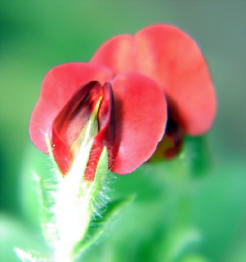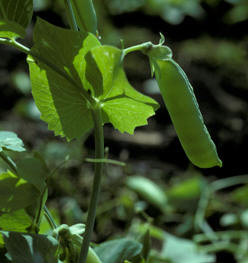Julie M. Falk
Adams County Master Gardener
 There are so many nice things about peas. First of all, you can plant them early, so you have an opportunity to dig in the dirt when itís still too cool to plant much else. Then you can test your creativity with string, sticks or
wire to make a support for the pea vines. On top of that, the pea flowers are quite lovely if you take the time to study them Ė their design is as complex as some orchids, though they are less showy. All forms of peas taste delicious and are nutritious. Finally, being legumes, the spent vines can be returned to the soil of
your garden with good effect.
There are so many nice things about peas. First of all, you can plant them early, so you have an opportunity to dig in the dirt when itís still too cool to plant much else. Then you can test your creativity with string, sticks or
wire to make a support for the pea vines. On top of that, the pea flowers are quite lovely if you take the time to study them Ė their design is as complex as some orchids, though they are less showy. All forms of peas taste delicious and are nutritious. Finally, being legumes, the spent vines can be returned to the soil of
your garden with good effect.
Pisum sativum (the pea plant) is a hardy, cool-season vegetable. In central Pennsylvania, peas can generally be planted in April. Itís possible to plant once the soil temperature reaches 45 degrees, but if you can wait until the temperature is 60 degrees, the peas will germinate more quickly. They
do not tolerate wet soil very well, so your garden spot should be well drained.
Plant the seeds 1 to 1.5 inches in depth, 1 inch apart in single or double rows. Rows should be 18-24 inches apart. Many varieties of peas grow tall, so are best supported on some type of trellis. You can use sticks and string, or pretty trellises from a catalog Ė the peas wonít care. Last year I
bought a trellis that looked like it belonged in an English garden, but didnít notice that the heirloom peas I planted were low-growing. Luckily, the trellis looked good naked.
 You can divide peas into three general categories. They all grow in a pod, but Garden or English peas are the ones that are removed from the pod at maturity. They should be shelled just before cooking. Some of the varieties recommended by
Penn State are Maestro, Knight or Lincoln. If youíre late planting, they suggest a variety called Wando, as it withstands warm weather a bit better. A second type of pea is the sugar snap. These have edible pods, and they are best when the pods first start to fatten, but the peas are not too large.
You can divide peas into three general categories. They all grow in a pod, but Garden or English peas are the ones that are removed from the pod at maturity. They should be shelled just before cooking. Some of the varieties recommended by
Penn State are Maestro, Knight or Lincoln. If youíre late planting, they suggest a variety called Wando, as it withstands warm weather a bit better. A second type of pea is the sugar snap. These have edible pods, and they are best when the pods first start to fatten, but the peas are not too large.
Cascadia, Sugar Ann and Sugar Sprint are bush type snap peas, while Super Sugar Snap grows on a trellis. If you leave sugar snaps on the vine too long, the pods become tough. The third class of pea is the snow pea. These are harvested when the pod is flat and the seeds are the size of BBs. They can
be eaten raw in salads, or steamed or stir-fried. Penn State recommends Oregon Sugar Pod, Mammoth Melting Sugar, or Dwarf Gray Sugar (which has red flowers and edible stems). My low-growing heirloom pea, the Asparagus pea, also has a red flower and dates back to colonial times.
I have had good luck growing peas without doing anything special at all. In the course of researching them, however, I did come across some considerations that I will pass along. Peas are legumes, so they use bacteria in the soil for "fixing" nitrogen. Pea
 plants will be more productive when they are inoculated with the Rhizobium bacteria, which is accomplished by sprinkling either the seeds or the seedbeds with the inoculate. Peas grow best in soil with a pH of 6.0 to 6.7, so if your plot is too acidic you
should correct that with lime.
plants will be more productive when they are inoculated with the Rhizobium bacteria, which is accomplished by sprinkling either the seeds or the seedbeds with the inoculate. Peas grow best in soil with a pH of 6.0 to 6.7, so if your plot is too acidic you
should correct that with lime.
Peas are not too plagued with diseases. The most common are fusarium wilt, powdery mildew and root rot. Recall that peas require well-drained soil. If you ensure that, you probably wonít have much trouble. Some varieties are known to be wilt-resistant, which is usually noted in the seed catalogs. By
rotating the crops in your garden from year to year, you can minimize the recurrence of plant pests and diseases.
One more good thing about planting peas in April: itís good therapy for tax depression!
Read other articles on growing herbs or vegetables
Read other articles by Julie Falk